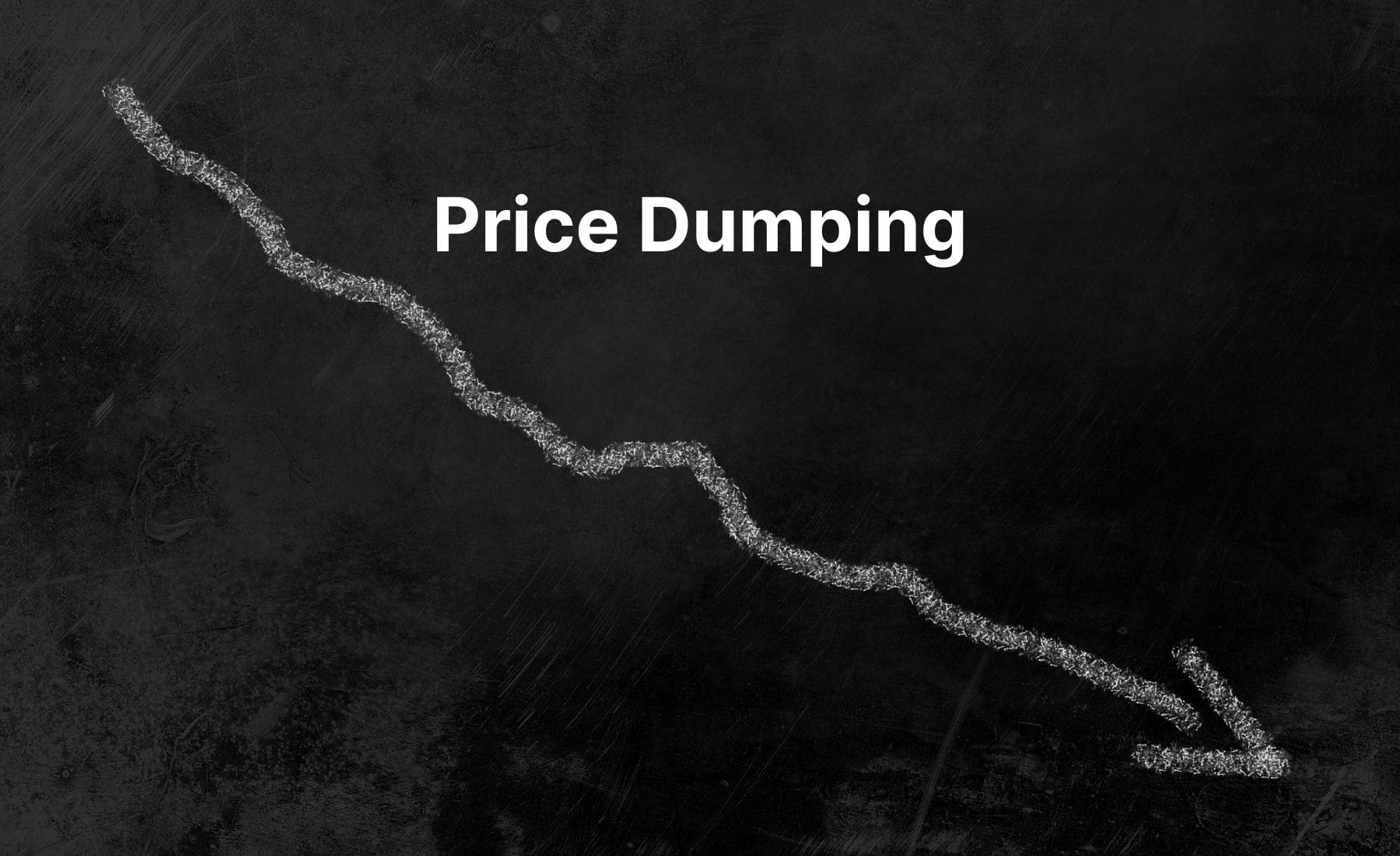Price dumping is a hot topic in international trade. Some see it as a way to gain market share quickly. Others argue it’s unfair and harmful to competition. This article will break down what price dumping is, the different types, and how it can impact businesses and market prices. We’ll also look at how it affects global trade and what you need to know to navigate this complex issue.
What is Price Dumping in International Trade?
Price dumping is when a company sells its products in a foreign market at a price lower than in its home country or even below the cost of production.
Companies engage in dumping for a few reasons. One common reason is market penetration. By offering a product at a price lower than competitors, they can quickly capture a large share of the market. Another reason is surplus disposal. Sometimes, companies have excess inventory they need to sell off, and dumping allows them to do this in a way that clears out stock and generates cash.
Example of Price Dumping:
In 2018, the U.S. government accused Chinese companies of dumping steel products in the U.S. market. Chinese companies were selling steel at prices significantly lower than the cost of production, which put American steel manufacturers at a severe disadvantage. To counter this, the U.S. imposed anti-dumping duties on Chinese steel to protect domestic producers and restore fair competition.
Source: U.S. slaps heavy duties on Chinese steel shipped from Vietnam, Reuters 22 May 2018
Price Discrimination in International Trade
Price discrimination can look the same as price dumping, but there’s a key difference. Both involve selling products at different prices in different markets, but the intent and impact are not the same.
Price discrimination is when a company adjusts prices based on what each market can afford. It’s a strategy to maximize profits by charging higher prices in wealthier markets and lower prices where consumers have less purchasing power. This approach is about optimizing revenue across various regions without necessarily harming competitors.
In contrast, the primary goal of price dumping is often to undercut local businesses, gain market share quickly, and potentially drive competitors out of business.
Example of Price Discrimination
A company might sell a smartphone at a premium price in a developed country while offering it at a lower price in a developing country. This is price discrimination, designed to fit the economic conditions of each market. However, if that company sold the same smartphone in a foreign market at a loss just to outcompete local brands, that would be price dumping.
Types of Dumping

There are different types of dumping, each with its own strategy and impact. Let’s go over the main ones with some examples.
Predatory Dumping
This is when a company lowers its prices in a foreign market with the goal of driving out competitors. The idea is to take over the market and through predatory pricing and eventually, raise prices again once competition is eliminated. For example, a company might sell electronics at a loss in another country to push local brands out of business.
Sporadic Dumping
Sporadic dumping happens when a company needs to quickly get rid of excess inventory. Instead of holding onto surplus stock, they sell it in a foreign market at a much lower price. This might happen if a seasonal product doesn’t sell well at home, so the company dumps it abroad to free up space and resources.
Persistent Dumping
This occurs when a company consistently sells its products at lower prices in a foreign market. The goal is to maintain a steady presence and attract ongoing demand. For instance, a company might regularly offer lower prices for their goods in a neighboring country to keep a strong foothold there.
Reverse Dumping
In reverse dumping, a company charges higher prices in foreign markets where demand is low. The logic here is that even with higher prices, the limited demand in that market will still lead to some sales. For example, a luxury car brand might sell its cars at a higher price in a country where there are only a few wealthy buyers, while offering them at lower prices in their home market where demand is stronger.
Impact of Price Dumping on Economies
Price dumping can have serious downsides, especially for the economies involved.
For the Importing Country
Dumping can harm local industries. When foreign products are sold at very low prices, the price of the product becomes a major factor, making it hard for domestic markets to compete. This can lead to factory closures and job losses. Over time, if local businesses are driven out, a monopoly might form. The foreign company that started with low prices can then raise them once there’s no competition left.
For the Exporting Country
Dumping isn’t without risks for the exporting country either. Other nations might respond with trade retaliation, like tariffs or quotas, to protect their own industries. This can make it harder for the exporting country to sell its goods abroad. Plus, selling at unsustainably low prices can hurt a company’s long-term profitability. It can also damage the brand’s reputation if consumers feel misled once prices go back up.
A well-known example of trade retaliation is the dispute between Airbus and Boeing. Both the U.S. and the EU accused each other of providing unfair subsidies to their respective aircraft manufacturers. This led to a long-running trade battle, where both sides imposed tariffs on billions of dollars’ worth of goods. The conflict escalated because each side wanted to protect its own industry from what it saw as unfair competition. This illustrates how price dumping or similar practices can strain trade agreements and lead to trade wars, where countries impose tariffs in response to perceived unfair practices.
Source: Boeing-Airbus trade row set to end after 17 years (bbc.com) – BBC 15 June 2012
Advantages of Dumping
While price dumping has many downsides, there are a few short-term benefits.
Consumers in the importing country can enjoy lower prices for a while. This means they get more for their money, at least temporarily.
The exporting company might gain a larger market share quickly. By offering lower prices, they can attract more customers and establish a strong presence in the new market.
The Role of the World Trade Organization (WTO)
The World Trade Organization (WTO) plays a key role in regulating dumping practices to ensure free trade remains fair and balanced. It doesn’t outright ban dumping but focuses on ensuring that trade remains fair. The WTO steps in when dumping causes harm to the domestic industry of an importing country.
Dumping is considered illegal by the WTO if it can be proven that the practice is damaging the economy of the importing country. For a country to take action, they must show that their domestic producers are suffering because of the dumped goods. When this happens, the affected country can file a complaint with the WTO. The WTO then reviews the case under the General Agreement on Tariffs and Trade (GATT) and decides whether anti-dumping measures should be applied.
Anti-Dumping Measures

When countries face price dumping, they often take steps to protect their industries. These steps are known as anti-dumping measures.
Import Tariffs
One common measure is import tariffs. Tariff is a tax placed on goods. The goal is to raise the price of these goods to match or exceed local prices. By doing this, domestic markets can compete more fairly. Import tariffs are a form of protectionism, designed to protect local jobs and industries but can also lead to higher prices for consumers.
Import Quotas
Another approach is import quotas, a type of trade barrier. This limits the amount of a particular dumped product that can enter the country. By restricting the supply, the market is less flooded with cheap goods, giving local businesses a better chance to survive. Quotas can be very effective but may also lead to shortages if the demand for the product is high.
Trade Disputes
Sometimes, these measures lead to trade disputes between countries. For example, the U.S. and the EU often respond to dumping by imposing tariffs or quotas on each other’s goods. If these actions are seen as unfair, the affected country can take the issue to the World Trade Organization (WTO). The WTO then steps in to mediate and ensure that all parties follow international trade rules.
Strategies for Businesses to Handle Dumping
When dealing with price dumping, both domestic and exporting companies need smart strategies to protect themselves and thrive.
For Domestic Companies
To stay in the game, domestic companies should focus on improving their production processes. By becoming more efficient, they can reduce costs and offer better products, making it harder for dumped goods to steal their market share.
It’s also important to adapt pricing strategies. Companies need to find ways to remain profitable, even when faced with lower-priced competition. This might mean offering discounts, bundling products, or finding other creative pricing solutions.
Domestic companies should also seek government support. This can include pushing for tariffs or quotas on dumped goods to level the playing field. These measures can provide much-needed protection from unfair competition.
For Exporting Companies
Exporting companies should avoid engaging in dumping practices. It’s crucial to calculate tariffs carefully and stick to fair trade practices. This helps maintain good relationships with other countries and avoids potential penalties.
While low prices can boost market share quickly, it’s important to think about the long-term impact. Companies should balance short-term gains with the need to maintain a strong brand reputation. Sustainable pricing strategies help ensure long-term success and avoid the risks associated with dumping.







